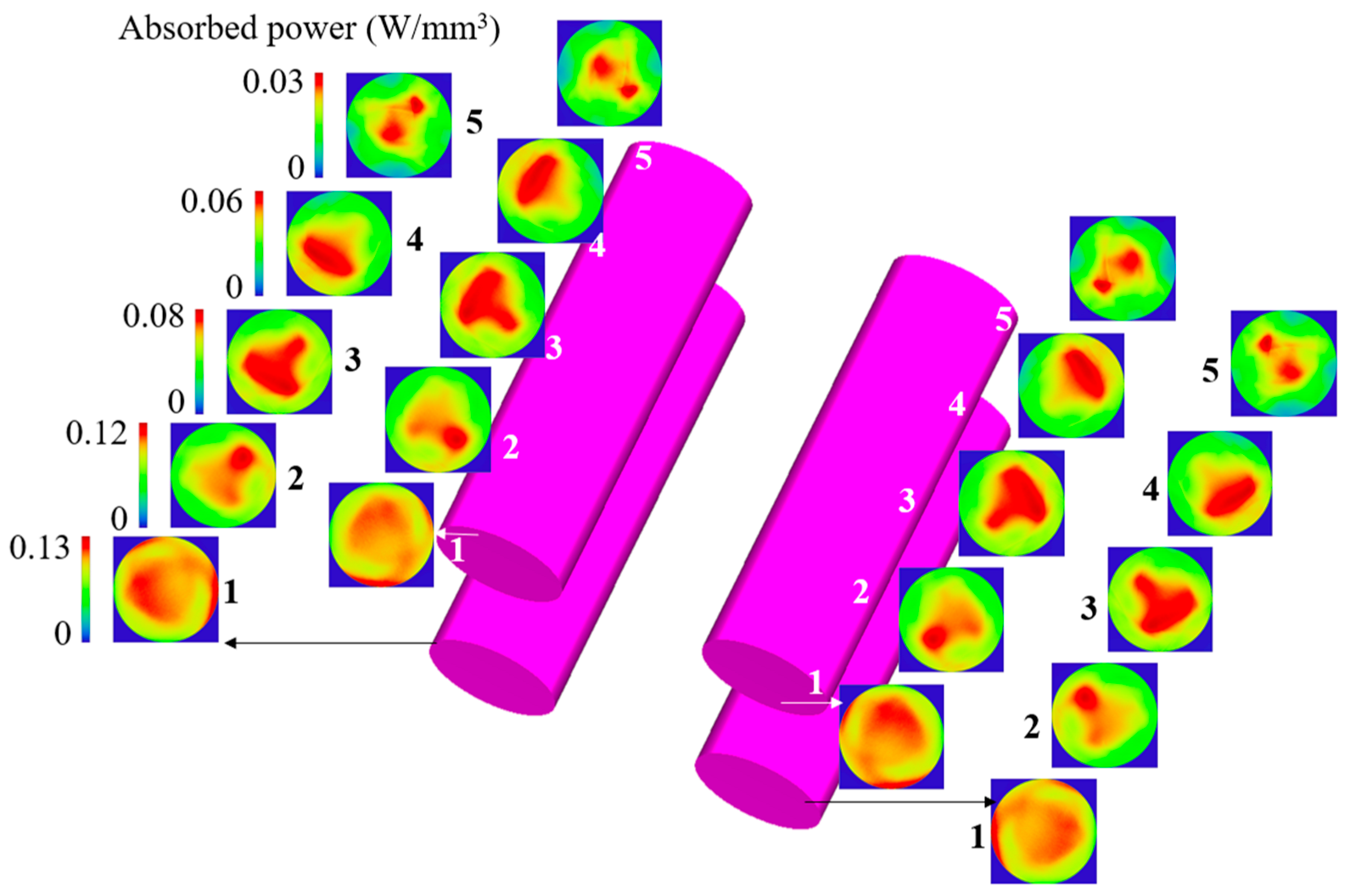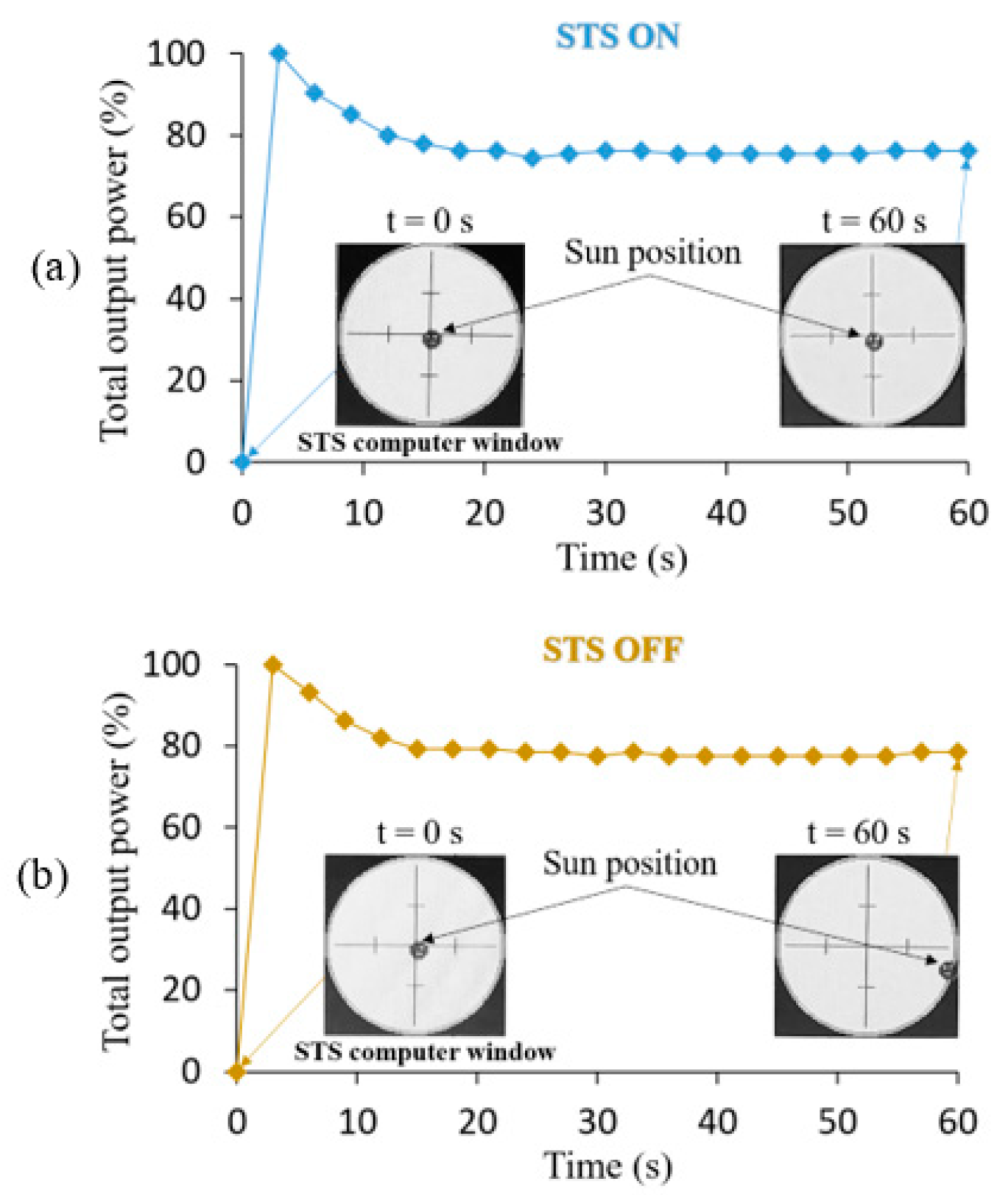Stable Emissions from a Four-Rod Nd:YAG Solar Laser with ±0.5° Tracking Error Compensation Capacity
Abstract
:1. Introduction
2. Materials
2.1. Solar Energy Collection and Concentration System
2.2. End-Side-Pumped Four-Rod Solar Laser Head
3. Methods and Measurements
4. Discussion
- The collection and concentration system: The end-side-pumped four-rod solar laser head was tested at the PROMES-CNRS MSSF facility, which presents a combined reflectance of only 59%. Still, the accurate dual-axis STS was crucial to demonstrate the stability of the total output power extracted from the solar laser prototype;
- Active media: Recent progress in solar-pumped laser efficiency has been possible by exploiting the superior absorption efficiency of the Ce:Nd:YAG laser medium [28]. However, thermal issues also increased, leading to the fracture of the active medium when subjected to intense solar pumping levels [15]. In contrast, the Nd:YAG crystal, while exhibiting a relatively lower absorption efficiency, stands as a well-established laser medium characterized by robust mechanical strength and good thermal conductivity. This makes it a prominent choice within the solid-state laser industry and solar laser research;
- Resonator length: The output mirrors are usually mounted relatively close (10–20 mm) from the AR 1064 nm coating to ensure that the energy of the higher-order modes is not wasted by diffraction losses [15]. In this experiment, the primary focus was not on achieving the highest efficiency, so each mini output mirror was positioned 70 mm away from the AR 1064 nm coating on the back-end face of each Nd:YAG rod. This spacing allowed for the proper installation and alignment of the complex opto-mechanics required to fix and calibrate the four separate mini output mirrors.
5. Conclusions
Author Contributions
Funding
Institutional Review Board Statement
Informed Consent Statement
Data Availability Statement
Acknowledgments
Conflicts of Interest
References
- Affan Ahmed, S.; Mohsin, M.; Zubair Ali, S.M. Survey and Technological Analysis of Laser and Its Defense Applications. Def. Technol. 2021, 17, 583–592. [Google Scholar] [CrossRef]
- Lv, J.; Peng, T.; Zhang, Y.; Wang, Y. A Novel Method to Forecast Energy Consumption of Selective Laser Melting Processes. Int. J. Prod. Res. 2021, 59, 2375–2391. [Google Scholar] [CrossRef]
- Laser Focus World Solar Pumping Converts Broadband Sunlight into Efficient Laser Light. Available online: https://www.laserfocusworld.com/lasers-sources/article/14283698/solar-pumping-converts-broadband-sunlight-into-efficient-laser-light (accessed on 21 December 2022).
- Graydon, O. A Sunny Solution. Nat. Photonics 2007, 1, 495–496. [Google Scholar] [CrossRef]
- Hemmati, H.; Biswas, A.; Djordjevic, I.B. Deep-Space Optical Communications: Future Perspectives and Applications. Proc. IEEE 2011, 99, 2020–2039. [Google Scholar] [CrossRef]
- Cowley, A.; Byrne, D.; Connor, N.O. Space Based Solar Power for Regenerative Atmospheric Geoengineering and Anthropogenic Pollution Control. In Proceedings of the 2nd Space Solar Power International Student and Young Professional Design Competition, Paris, France, January 2013; pp. 1–6. Available online: https://www.esa.int/gsp/ACT/doc/nrg/SPS%202013/P3%20-%20Space%20Based%20Solar%20Power%20for%20Regenerative%20Atmospheric.pdf (accessed on 21 December 2022).
- Vasile, M.; Maddock, C.A. Design of a Formation of Solar Pumped Lasers for Asteroid Deflection. Adv. Space Res. 2012, 50, 891–905. [Google Scholar] [CrossRef]
- De Young, R.J.; Walberg, G.D.; Conway, E.J.; Jones, L.W. A NASA High-Power Space-Based Laser Research and Applications Program; IV. Series, NASA SP-464; National Aeronautics and Space Administration; Scientific and Technical Information Branch: Washington, DC, USA, 1983.
- Lando, M.; Kagan, J.A.; Shimony, Y.; Kalisky, Y.Y.; Noter, Y.; Yogev, A.; Rotman, S.R.; Rosenwaks, S. Solar-Pumped Solid State Laser Program. In Proceedings of the 10th Meeting on Optical Engineering in Israel, Jerusalem, Israel, 2–6 March 1997; Shladov, I., Rotman, S.R., Eds.; SPIE: Cergy-Pontoise, France; Volume 3110, p. 196. [Google Scholar]
- Kiss, Z.J.; Lewis, H.R.; Duncan, R.C. Sun Pumped Continuous Optical Maser. Appl. Phys. Lett. 1963, 2, 93–94. [Google Scholar] [CrossRef]
- Young, C.G. A Sun-Pumped CW One-Watt Laser. Appl. Opt. 1966, 5, 993–997. [Google Scholar] [CrossRef]
- Yabe, T.; Ohkubo, T.; Uchida, S.; Yoshida, K.; Nakatsuka, M.; Funatsu, T.; Mabuti, A.; Oyama, A.; Nakagawa, K.; Oishi, T.; et al. High-Efficiency and Economical Solar-Energy-Pumped Laser with Fresnel Lens and Chromium Codoped Laser Medium. Appl. Phys. Lett. 2007, 90, 261120. [Google Scholar] [CrossRef]
- Dinh, T.H.; Ohkubo, T.; Yabe, T.; Kuboyama, H. 120 Watt Continuous Wave Solar-Pumped Laser with a Liquid Light-Guide Lens and an Nd:YAG Rod. Opt. Lett. 2012, 37, 2670–2672. [Google Scholar] [CrossRef]
- Guan, Z.; Zhao, C.; Li, J.; He, D.; Zhang, H. 32.1 W/M2 Continuous Wave Solar-Pumped Laser with a Bonding Nd:YAG/YAG Rod and a Fresnel Lens. Opt. Laser Technol. 2018, 107, 158–161. [Google Scholar] [CrossRef]
- Liang, D.; Vistas, C.R.; Garcia, D.; Tibúrcio, B.D.; Catela, M.; Costa, H.; Guillot, E.; Almeida, J. Most Efficient Simultaneous Solar Laser Emissions from Three Ce:Nd:YAG Rods within a Single Pump Cavity. Sol. Energy Mater. Sol. Cells 2022, 246, 111921. [Google Scholar] [CrossRef]
- Cai, Z.; Zhao, C.; Zhao, Z.; Zhang, J.; Zhang, Z.; Zhang, H. Efficient 38.8 W/M2 Solar Pumped Laser with a Ce:Nd:YAG Crystal and a Fresnel Lens. Opt. Express 2023, 31, 1340–1353. [Google Scholar] [CrossRef] [PubMed]
- Masuda, T.; Iyoda, M.; Yasumatsu, Y.; Dottermusch, S.; Howard, I.A.; Richards, B.S.; Bisson, J.-F.; Endo, M. A Fully Planar Solar Pumped Laser Based on a Luminescent Solar Collector. Commun. Phys. 2020, 3, 60. [Google Scholar] [CrossRef]
- Tibúrcio, B.D.; Liang, D.; Almeida, J.; Garcia, D.; Catela, M.; Costa, H.; Vistas, C.R. Tracking Error Compensation Capacity Measurement of a Dual-Rod Side-Pumping Solar Laser. Renew. Energy 2022, 195, 1253–1261. [Google Scholar] [CrossRef]
- Angulo-Calderón, M.; Salgado-Tránsito, I.; Trejo-Zúñiga, I.; Paredes-Orta, C.; Kesthkar, S.; Díaz-Ponce, A. Development and Accuracy Assessment of a High-Precision Dual-Axis Pre-Commercial Solar Tracker for Concentrating Photovoltaic Modules. Appl. Sci. 2022, 12, 2625. [Google Scholar] [CrossRef]
- Catela, M.; Liang, D.; Vistas, C.R.; Garcia, D.; Costa, H.; Tibúrcio, B.D.; Almeida, J. Highly Efficient Four-Rod Pumping Approach for the Most Stable Solar Laser Emission. Micromachines 2022, 13, 1670. [Google Scholar] [CrossRef]
- Catela, M.; Liang, D.; Vistas, C.R.; Costa, H.; Garcia, D.; Tibúrcio, B.D.; Almeida, J. Solar Laser Pumping Approach for Both Simultaneous and Stable Multibeam Operation under Tracking Error Condition. J. Photon Energy 2023, 13, 028001. [Google Scholar] [CrossRef]
- Olsen, F.O.; Hansen, K.S.; Nielsen, J.S. Multibeam Fiber Laser Cutting. J. Laser Appl. 2009, 21, 133–138. [Google Scholar] [CrossRef]
- Gillner, A.; Finger, J.; Gretzki, P.; Niessen, M.; Bartels, T.; Reininghaus, M. High Power Laser Processing with Ultrafast and Multi-Parallel Beams. J. Laser Micro Nanoeng. 2019, 14, 129–137. [Google Scholar] [CrossRef]
- Bruening, S.; Du, K.; Jarczynski, M.; Jenke, G.; Gillner, A. Ultra-Fast Laser Micro Processing by Multiple Laser Spots. Procedia CIRP 2018, 74, 573–580. [Google Scholar] [CrossRef]
- ASTM Standard G173-03; Standard Tables for Reference Solar Spectral Irradiances: Direct Normal and Hemispherical on 37 Tilted Surface. ASTM International: West Conshohocken, PA, USA, 2012.
- Weksler, M.; Shwartz, J. Solar-Pumped Solid-State Lasers. IEEE J. Quantum Electron. 1988, 24, 1222–1228. [Google Scholar] [CrossRef]
- Koechner, W. Solid-State Laser Engineering; Springer Series in Optical Sciences, 6th ed.; Springer: New York, NY, USA, 2006; ISBN 978-0-387-29338-7. [Google Scholar]
- Payziyev, S.; Sherniyozov, A. Influence of Thermal Population of Lower Laser Levels on the Performance of End-Side-Pumped Ce:Nd:YAG Solar Laser. J. Photon-Energy 2022, 12, 044501. [Google Scholar] [CrossRef]








| Tibúrcio et al. (2022) [18] | This Study | Improvement | |
|---|---|---|---|
| ∆P±0.5° | 8% | 1% | 8.0 times |
| ∆P±1.0° | - | 8% | - |
| TEW8% | 1.0° | 2.0° | 2.0 times |
Disclaimer/Publisher’s Note: The statements, opinions and data contained in all publications are solely those of the individual author(s) and contributor(s) and not of MDPI and/or the editor(s). MDPI and/or the editor(s) disclaim responsibility for any injury to people or property resulting from any ideas, methods, instructions or products referred to in the content. |
© 2023 by the authors. Licensee MDPI, Basel, Switzerland. This article is an open access article distributed under the terms and conditions of the Creative Commons Attribution (CC BY) license (https://creativecommons.org/licenses/by/4.0/).
Share and Cite
Catela, M.; Liang, D.; Almeida, J.; Costa, H.; Garcia, D.; Tibúrcio, B.D.; Guillot, E.; Vistas, C.R. Stable Emissions from a Four-Rod Nd:YAG Solar Laser with ±0.5° Tracking Error Compensation Capacity. Photonics 2023, 10, 1047. https://doi.org/10.3390/photonics10091047
Catela M, Liang D, Almeida J, Costa H, Garcia D, Tibúrcio BD, Guillot E, Vistas CR. Stable Emissions from a Four-Rod Nd:YAG Solar Laser with ±0.5° Tracking Error Compensation Capacity. Photonics. 2023; 10(9):1047. https://doi.org/10.3390/photonics10091047
Chicago/Turabian StyleCatela, Miguel, Dawei Liang, Joana Almeida, Hugo Costa, Dário Garcia, Bruno D. Tibúrcio, Emmanuel Guillot, and Cláudia R. Vistas. 2023. "Stable Emissions from a Four-Rod Nd:YAG Solar Laser with ±0.5° Tracking Error Compensation Capacity" Photonics 10, no. 9: 1047. https://doi.org/10.3390/photonics10091047
APA StyleCatela, M., Liang, D., Almeida, J., Costa, H., Garcia, D., Tibúrcio, B. D., Guillot, E., & Vistas, C. R. (2023). Stable Emissions from a Four-Rod Nd:YAG Solar Laser with ±0.5° Tracking Error Compensation Capacity. Photonics, 10(9), 1047. https://doi.org/10.3390/photonics10091047







